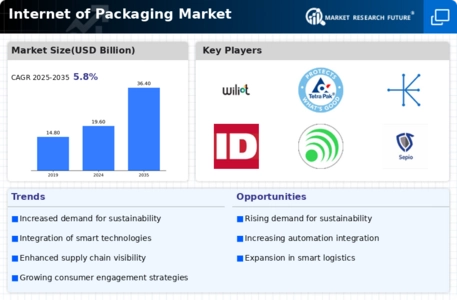Internet Of Packaging Size
Internet of Packaging Market Growth Projections and Opportunities
The market size in the Internet of Packaging (IoP) industry is an ever-changing and rapidly developing sector that various market drivers highly influence. These factors include a growing interest in smart packaging solutions across almost every industry, which is one of the main triggers behind changes in the IoP landscape. Interest in packages has gone beyond the containment of traditional purposes as well, following rising consumer environmental awareness and tech-savviness. In 2022, it was valued at USD 17.5 bn, meaning that its compound average growth rate would be 5.80%, hence becoming worth around USD 29.1bn by the year 2032. On top of this, an increase in focus pertaining to supply chain visibility also stands as yet another important market factor. To achieve this objective, companies are increasingly attempting to optimize and streamline their supply chain operations, leading to a critical role played by IoP in enhancing these efforts. By incorporating sensors and connectivity into packages, real-time monitoring for products becomes possible as they move through different stages of the supply chain, thereby offering valuable insights about their location, status, and potential problems, among other issues that could be monitored during transportation process, among other things concerning location; quality conditionality on what stage product gets affected or spoiled. The IoP market is being shaped by changes in regulations related to packing and traceability, hence propelling its growth worldwide as governments and trade unions are increasingly implementing stringent guidelines regarding this aspect. Product safety labeling sustainability compliance with these policies remains a top priority for firms today due to business ethics making use of IoT technology, thus helping organizations not only meet regulatory requirements but also be seen as transparent, accountable citizens. Therefore, adherence to standards set up by industries like government regulations becomes a reason why adoption takes place for Internet of Packaging (IoP) Technologies since there are needs required that must met. However, the expense incurred while implementing IoP solutions acts as one of the obstacles to growth in the market. Though smart packaging is deemed beneficial, it is associated with initial costs, such as technology infrastructure investment and sensors, among other communication systems, when businesses roll out this unique strategy. Small enterprises may find it difficult to allocate resources for IoP implementation, especially due to their size. Conversely, the IoP market is highly driven by competition and industry partnerships. Collaboration between packaging firms, technology providers, and other stakeholders becomes critical as the sector matures. It is through strategic alliances and partnerships that comprehensive ioP solutions addressing the diverse demand requirements of industries can be developed, thus resulting in enhanced competitiveness among companies operating within this space. Innovation driven by competition in the Internet of Things (IoT) market has also pushed players into continuously upgrading their offerings to remain ahead in a rapidly changing world that embraces IoT.



 Source: Secondary Research, Primary Research, Market Research Future Database and Analyst Review
Source: Secondary Research, Primary Research, Market Research Future Database and Analyst Review









Leave a Comment